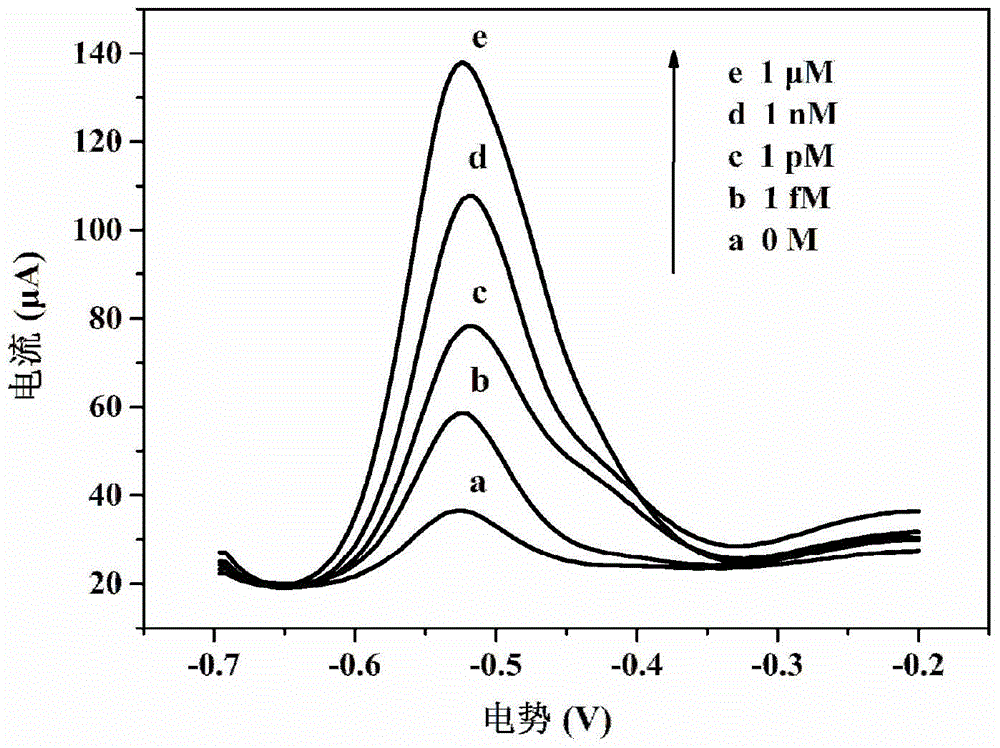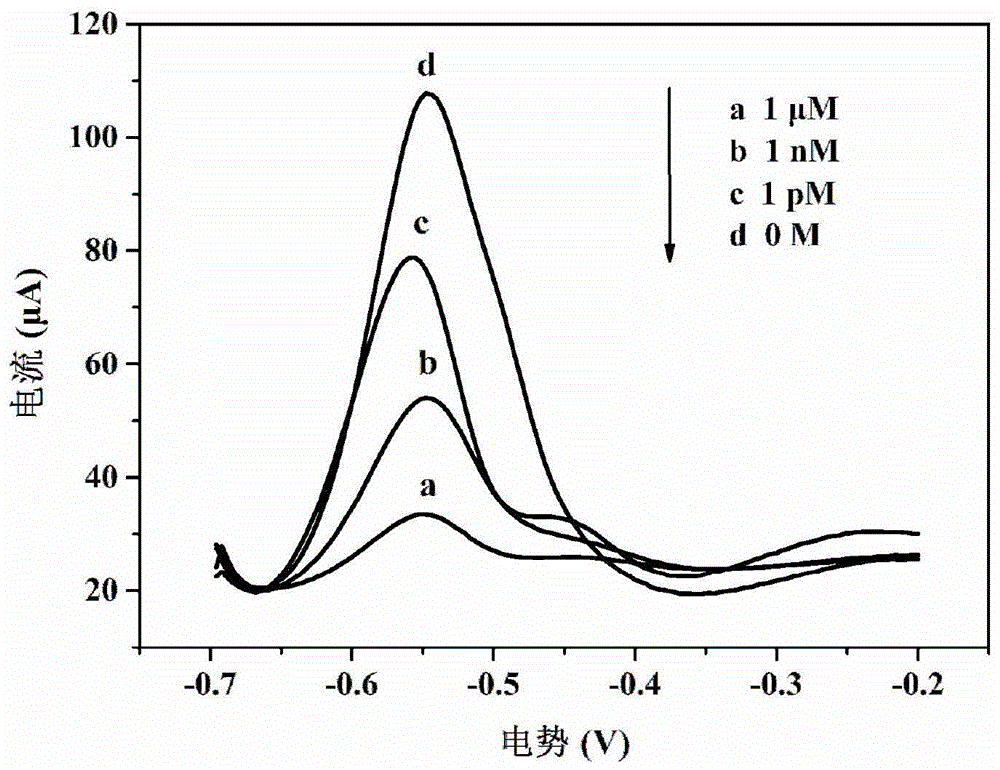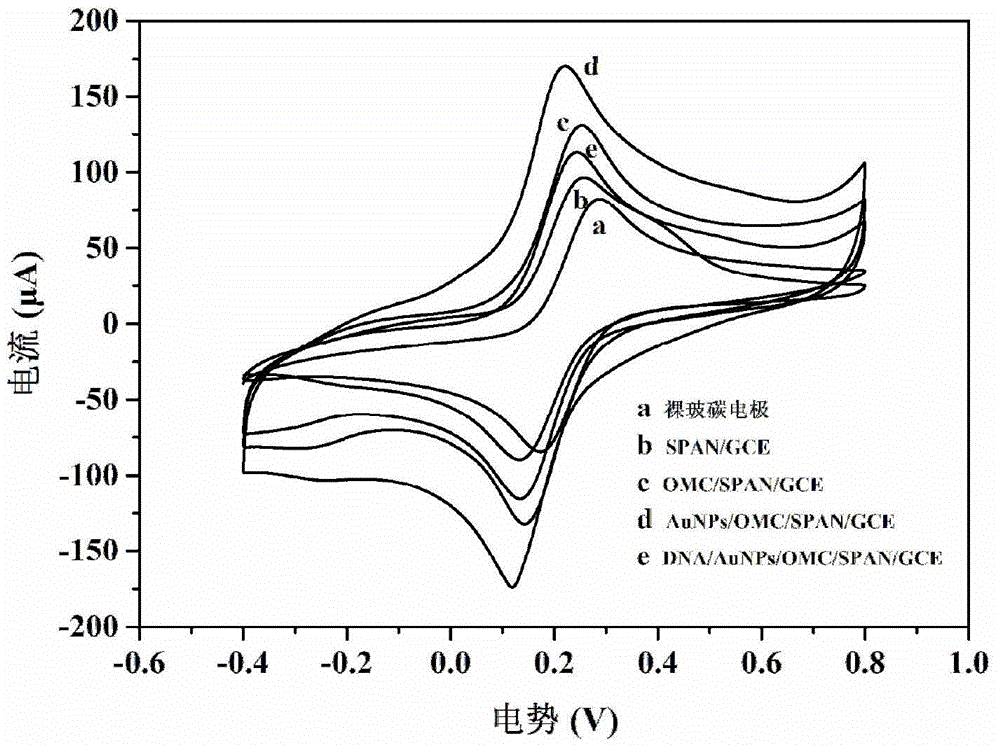Mercuric ion or cysteine detecting electrochemical DNA biosensor and manufacturing method and application thereof
A cysteine, electrochemical technology, applied in the field of biosensors, can solve the problems of low detection limit, can not be used to detect a variety of substances, etc., to achieve the effect of low detection limit, wide detection range, strong anti-interference ability
- Summary
- Abstract
- Description
- Claims
- Application Information
AI Technical Summary
Problems solved by technology
Method used
Image
Examples
Embodiment 1
[0060] An electrochemical DNA sensor for detecting mercury ions or cysteine, including a glassy carbon electrode used as a working electrode in a three-electrode system, the surface of the glassy carbon electrode reaction end is modified with a composite film, and the composite film is from the inside to the The composite film is composed of self-doped polyaniline nanofibers, ordered mesoporous carbon and gold nanoparticles arranged in sequence on the outside, and DNA capture probes are self-assembled on the surface of the composite membrane, and the DNA capture probes can be passed through T-Hg 2+ -T structural mismatch forms a hairpin structure.
[0061] The DNA capture probe is the nucleotide sequence of SEQ ID NO.1, specifically:
[0062] 5'-SH-(CH 2 ) 6 - TTCTTTCTTCCCCTTGTTTGTT-3'
[0063] When the above electrochemical DNA sensor is placed in the solution to be tested containing mercury ions, the 3' end "TTGTTTGTT" of the DNA capture probe will fold with the 5' end "T...
Embodiment 2
[0069] A preparation method of the above-mentioned electrochemical DNA sensor for detecting mercury ions or cysteine, comprising the following steps:
[0070] S1. Modified self-doped polyaniline nanofibers (SPAN): 6 μL of SPAN suspension was added dropwise on the surface of the cleaned glassy carbon electrode to obtain a SPAN-modified glassy carbon electrode, namely SPAN / GCE. image 3 Shows the SPAN / GCE in 5.0mM ferricyanide solution containing 0.1MKCl ([Fe(CN) 6 ] 3- / 4- ) of the cyclic voltammograms measured in ) (please confirm).
[0071] The SPAN is synthesized by a one-step chemical oxidation method, and the specific steps are:
[0072] Dissolve 0.22g of cetyltrimethylammonium bromide (CTAB), 0.46g of aniline (AN), and 0.86g of 2-aminobenzenesulfonic acid (ABS) in 80mL of 0.15M hydrochloric acid solution, and then add 40mL of 0.06M ammonium persulfate (APS) solution, put it at 5°C for 24h, and finally filter the resulting dark green precipitate, wash it with deionized wat...
Embodiment 3
[0082] The application of the electrochemical DNA sensor of a kind of embodiment 1 in detecting mercury ion, comprises the following steps:
[0083] (1) Soak the gold nanoparticles / ordered mesoporous carbon / self-doped polyaniline nanofiber-modified glassy carbon electrode reaction ends assembled with DNA capture probes in solutions containing different concentrations of mercury ions for 1 h (mercury ions Concentrations were 1×10 - 6 M, 1×10 -7 M, 1×10 -8 M, 1×10 -9 M, 1×10 -10 M, 1×10 -11 M, 1×10 -12 M, 1×10 -13 M, 1×10 -14 M), take out the glassy carbon electrode and rinse it with TBS buffer solution, then soak it in the solution containing the signal indicator AQDS for 6h, take it out, rinse it and dry it for later use.
[0084] (2) the glassy carbon electrode after step (1) is processed as a working electrode, the saturated calomel electrode is used as a reference electrode, and the platinum electrode is used as a counter electrode to establish a three-electrode sy...
PUM
 Login to View More
Login to View More Abstract
Description
Claims
Application Information
 Login to View More
Login to View More - R&D
- Intellectual Property
- Life Sciences
- Materials
- Tech Scout
- Unparalleled Data Quality
- Higher Quality Content
- 60% Fewer Hallucinations
Browse by: Latest US Patents, China's latest patents, Technical Efficacy Thesaurus, Application Domain, Technology Topic, Popular Technical Reports.
© 2025 PatSnap. All rights reserved.Legal|Privacy policy|Modern Slavery Act Transparency Statement|Sitemap|About US| Contact US: help@patsnap.com



